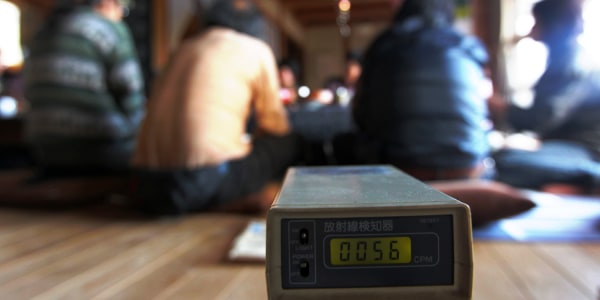Japan pumped nitrogen gas into a crippled nuclear reactor Thursday, refocusing the fight against the world's worst nuclear disaster in 25 years on preventing an explosive buildup of hydrogen gas at Fukushima Dai-ichi power plant.
Workers started injecting nitrogen into the containment vessel of reactor No. 1 after finally stopping highly radioactive water leaking into the sea at another reactor in the six-reactor complex on Wednesday.
The possibility of another hydrogen explosion like those that ripped through reactors 1 and 3 early in the crisis, spreading high levels of radiation into the air, was "extremely low," an official of plant operator Tokyo Electric Power Co. told a news briefing.
But TEPCO suspected that the outside casing of the reactor vessel was damaged, said the official.
"Under these conditions, if we continue cooling the reactors with water, the hydrogen leaking from the reactor vessel to the containment vessel could accumulate and could reach a point where it could explode," he added.
Although engineers succeeded after days of desperate efforts to plug the leak at reactor No. 2, they still need to pump more than 3 million gallons (11 million liters) of contaminated water back into the ocean because they have run out of storage space at the facility. The water was used to cool overheated fuel rods.
Nuclear experts said the damaged reactors were far from being under control almost a month after they were hit by a massive earthquake and tsunami on March 11 that killed as many as 25,000 people and destroyed hundreds of miles of coastline.
Unable to restore normal cooling systems because water has damaged them and radioactivity has made conditions dangerous, workers have resorted to pumping water into the reactors and letting it gush wherever it can.
Slideshow 9 photos
After Japan's earthquake and tsunami - week 8
Superheated fuel rods can pull explosive hydrogen from cooling water, so now that more water is going into the reactors, the concern is that hydrogen levels are rising.
The nitrogen pumping also has risks, but Japan's Nuclear and Industrial Safety Agency approved it as a necessary measure to avoid danger, agency spokesman Hidehiko Nishiyama said. The injection could release radioactive vapor into the environment, but residents within 12 miles (20 kilometers) of the plant have been evacuated.
The government said Wednesday it might consider expanding that zone, though not because of the nitrogen injection. An expansion might not necessarily mean the radiation that has been spewing into the air and water from the plant is getting worse. The effects of radiation are determined by both the strength of the dose and the length of exposure, so the concern is that people farther away might start being affected as the crisis drags on.
"I would imagine residents in areas facing a possibility for long-term exposure are extremely worried," Chief Cabinet Secretary Yukio Edano said. "We are currently consulting with experts so that we can come up with a clear safety standard."
Edano did not say how far the zone might be expanded or how many people might be affected. Tens of thousands have been living in shelters since the tsunami, either because they lost their homes or are in the evacuation zone or both.
Police in hard-hit Fukushima prefecture prepared to launch a full-scale search for bodies in the evacuation zone Thursday. Nearly 250 agents from the Tokyo Metropolitan Police will join local police searching for 4,200 people still missing there.
At the plant, 140 miles (220 kilometers) northeast of Tokyo, workers finally halted the leak of highly contaminated water that raised worry about the safety of seafood caught off the coast.
But even that rare good news came with a caveat. Highly contaminated water pooling around the plant has often made it difficult or impossible for workers to access some areas because of concerns about radiation exposure. Now that the leak has stopped, the pooling could actually get worse because water that had been going into the ocean could back up onto the grounds of the complex.
When water was still leaking into the ocean, officials said it would quickly dissipate in the vast Pacific, but the mere suggestion that seafood could be at risk stirred worries throughout Japan's fishing industry. Water with lower levels of radioactivity is also being dumped into the sea to make room to store other water with higher levels of contamination on the plant grounds.
In the coastal town of Ofunato, Takeyoshi Chiba, who runs the town's wholesale market, warily watched developments at the plant, about 120 miles (200 kilometers) down the coast.
"There is a chance that the water from Fukushima will come here," he said, explaining that area fishermen still haven't managed to get out to sea again after the tsunami destroyed nearly all of their boats. "If Tokyo decides to ban purchases from here, we're out of business."
This week, the government set its first-ever standard for the amount of radiation allowed in fish after levels in waters near the plant measured several million times the legal limit and elevated levels were found in some fish. The standard is the same as one already in place for vegetables.
Stopping the leak by injecting several chemicals into the area around it seemed to help cut down on radiation. By afternoon, radiation at a point 360 yards (330 meters) off the coast was 280 times the legal limit, down from a high of more than 4,000, although Edano said plant operator TEPCO was still watching closely.
"Right now, just because the leak has stopped, we are not relieved yet," Edano said. "We are checking whether the leak has completely stopped, or whether there may be other leaks."

